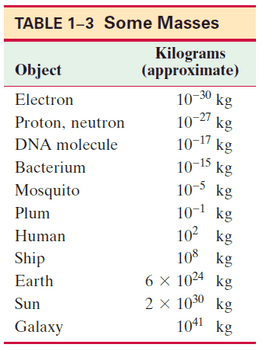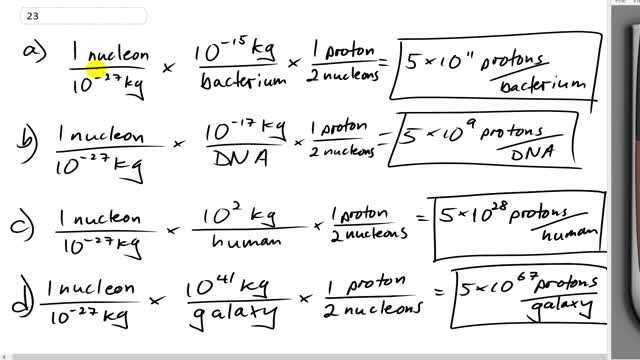
Use Table 1–3 to estimate the total number of protons or neutrons in
- a bacterium,
- a DNA molecule,
- the human body,
- our Galaxy.

b)
c)
d)

In order to watch this solution you need to have a subscription.
This is Giancoli Answers with Mr. Dychko. Protons and neutrons are both nucleons and so we can see from that table 1–3 that a proton or a neutron or collectively you can refer to them as nucleons; one nucleon has a mass of 10 to the negative 27 kilograms and we multiply that by 10 to the minus 15 kilograms per bacterium and then I'm gonna multiply it by a half because there's about approximately 1 proton for every 2 nucleons because most atoms have as many neutrons as they have protons and you can check that on Wikipedia, there's neutron-proton ratio. So for most elements up to about element number 20, they have a neutron to proton ratio of about 1 so there are as many neutrons as protons and most mass in universe consists of light elements because the heavier elements are created only in large supernovae or large stellar events that are uncommon compared to the more common events that make these lighter elements so most mass has a ratio of 1 proton for every 1 neutron. So that means for every 2 nucleons that you are considering, one of them is gonna be a proton. So we multiply this result here by half and we get 10 to the 15 protons per bacterium. And for DNA, it's the same calculation but you have 10 to the negative 17 kilograms for every DNA and we get 5 times 10 to the 9 protons per DNA molecule and then 1 nucleon for every 10 to the minus 27 kilograms times 10 to the 2 kilograms per human approximately times 1 proton for every 2 nucleons gives 5 times 10 to the 28 protons per human. And then both of these conversion or factors multiplied by 10 to the 41 kilograms per galaxy gives us 5 times 10 to the 67 protons per galaxy and then here is a calculator showing you those calculations.